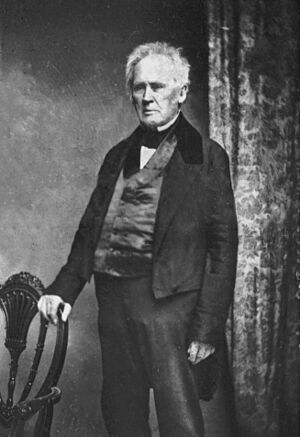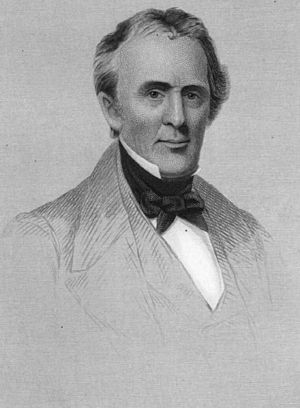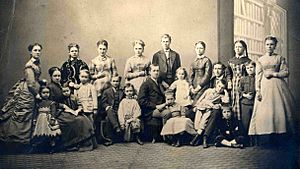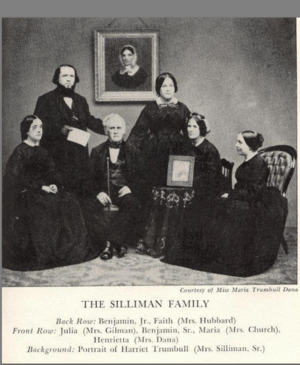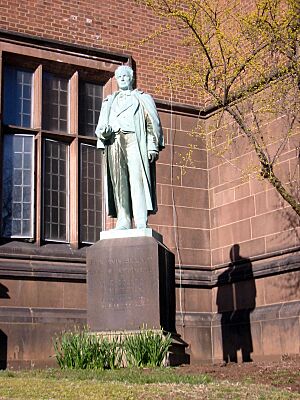Benjamin Silliman facts for kids
Quick facts for kids
Benjamin Silliman
|
|
|---|---|

Silliman around 1850
|
|
| Born | August 8, 1779 Trumbull, Connecticut, United States
|
| Died | November 24, 1864 (aged 85) New Haven, Connecticut, United States
|
| Nationality | United States |
| Alma mater | Yale University |
| Known for | Distillation of petroleum |
| Awards | National Academy of Sciences |
| Scientific career | |
| Fields | chemist |
| Institutions | Yale University |
| Doctoral students | James Dwight Dana |
Benjamin Silliman (born August 8, 1779 – died November 24, 1864) was an early American chemist and science teacher. He was one of the first science professors at Yale College. He was also the first person to separate petroleum into different parts in America. Benjamin Silliman also started the American Journal of Science, which is the oldest science magazine in the United States that has been published without stopping.
Contents
Early Life and Education
Benjamin Silliman was born in a town called Trumbull, Connecticut. This happened a few months after his mother had to leave their home to escape British soldiers during the American Revolution. His father, General Gold Selleck Silliman, had been taken prisoner by the British.
Silliman went to Yale and earned his first degree in 1796. He later studied law. From 1799 to 1802, he worked as a tutor at Yale. In 1802, Yale's president, Timothy Dwight IV, hired Silliman to be a professor of chemistry and natural history. This was surprising because Silliman had never studied chemistry before!
To get ready for his new job, Silliman studied chemistry at the University of Pennsylvania. He gave his first chemistry lectures at Yale in 1804. These were the first science lectures ever given at Yale. In 1805, he traveled to Edinburgh to learn even more.
Amazing Discoveries and Work
When Silliman returned to New Haven, he started studying the geology of the area. He also analyzed a meteorite that fell near Weston, Connecticut. He wrote the first scientific report about an American meteorite.
In 1808, he gave public lectures in New Haven. He helped discover many elements found in different minerals. Around 1818, a man named Ephraim Lane brought some rocks to Silliman for identification. Silliman found tungsten, tellurium, topaz, and fluorite in these rocks. He published his findings in his new magazine, the American Journal of Science. This magazine covered all natural sciences, especially geology.
Silliman also played a big part in finding the first fossil fish in the United States. In 1850, a mineral was named after him, called sillimanite. When the Medical School was created, he also taught there as one of the first teachers.
Benjamin Silliman believed that the Earth was much older than what some people thought based on the Bible. He argued that the Bible's timeline mainly focused on human history, and that the Earth existed for many ages before humans. He also spoke out against ideas that did not believe in a Creator.
Supporting Coeducation
Silliman was an early supporter of allowing both boys and girls to learn together in college. Even though Yale didn't officially accept women students until much later, he let young women attend his science lectures. His efforts helped convince other educators that women should be allowed to study in colleges.
Petroleum and Oil Exploration
Benjamin Silliman Sr. was the first person to use a process called fractional distillation. This process separates different parts of a liquid. In 1854, his son, Benjamin Silliman Jr., became the first to use this process to separate petroleum (crude oil).
In 1864, Silliman noticed natural oil seeps in the Ojai, California area. This observation later led to the start of oil exploration and development in that region in 1866.
The 1807 Meteorite
On December 14, 1807, a bright fireball was seen in the sky over Vermont and Massachusetts. Then, three loud explosions were heard over Weston, Connecticut. Stone pieces fell in at least six different places.
Silliman and his colleague spent hours looking for the meteorite pieces. The largest and only unbroken stone, weighing 36.5 pounds (about 16.5 kilograms), was found by a farmer named Elijah Seeley. People encouraged Seeley to give it to Yale, but he wanted to sell it. It was bought by Colonel George Gibbs for his large collection. In 1825, when Yale bought Gibbs's collection, Silliman finally got this important meteorite. It is still at the Yale Peabody Museum today.
Family Life

Benjamin Silliman married Harriet Trumbull in 1809. Her father and grandfather were both governors of Connecticut and heroes of the American Revolution. Benjamin and Harriet had four children. Two of their daughters married professors at Yale, including James Dwight Dana, who was Silliman's student and assistant. His son, Benjamin Silliman Jr., also became a chemistry professor at Yale. He wrote a report that helped investors decide to support the search for oil.
After Harriet passed away, Silliman married Mrs. Sarah Isabella (McClellan) Webb in 1851. Benjamin Silliman died in New Haven and is buried in Grove Street Cemetery.
Legacy and Impact
Silliman believed that slavery was a terrible thing. He supported the idea of helping free African Americans move to Liberia. He was also a member of important groups like the American Antiquarian Society and the American Academy of Arts and Sciences.
He founded and edited the American Journal of Science, which became a very important science publication. The United States Congress also appointed him as one of the founding members of the National Academy of Sciences.
Things Named After Him
- Silliman College, one of Yale's student dorms, is named for him.
- The mineral Sillimanite is named after him.
- In Sequoia National Park, Mount Silliman is named for him, along with Silliman Pass, a creek, and two lakes near the mountain.
See also
 In Spanish: Benjamin Silliman para niños
In Spanish: Benjamin Silliman para niños



